Birds 101
Bringing Your Baby Home
We receive so many questions about what you will need when you’re bringing your baby bird home. The following video will answer quite a few questions. If you still need help, don’t hesitate to send us a message!
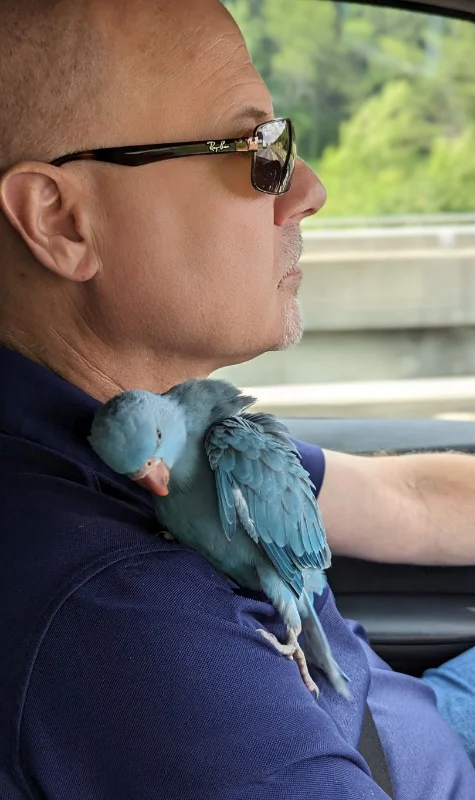
Table of Contents
Nutrition
- What Do I Feed My Bird?
A balanced, healthy avian diet should include: 60 to 70% quality pellets, 30-40% fresh chop and 10-15% of a premium seed blend.
- What is Chop?
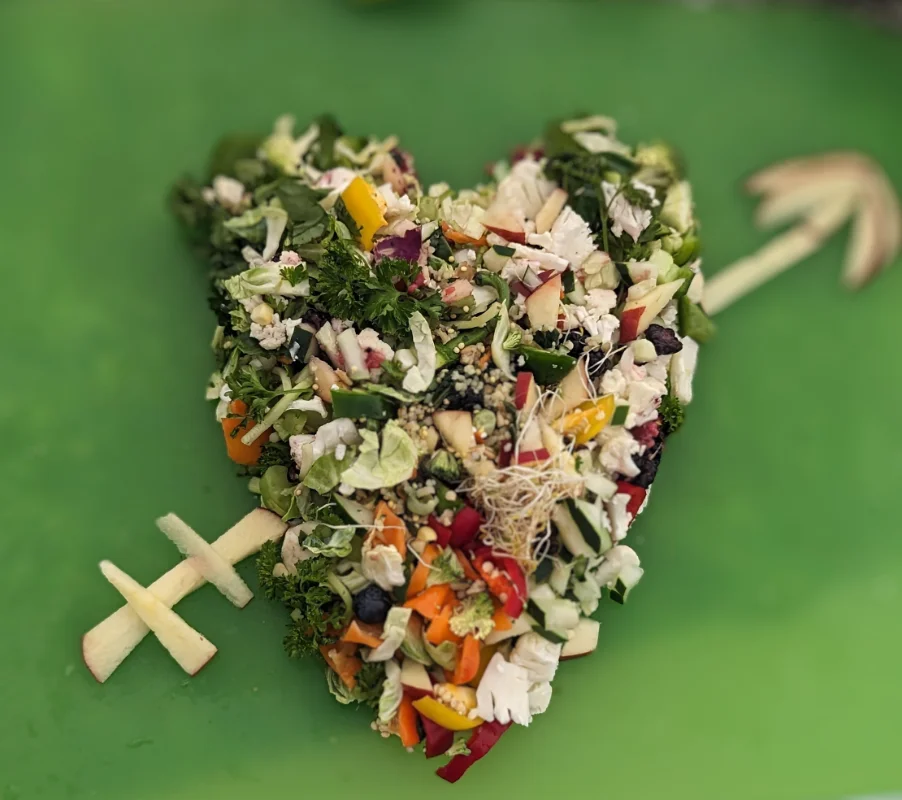
Chop is simply fruits, veggies, legumes and/or grains that are prepared fresh and served daily as an integral part of your bird’s diet. Can you prepare chop and freeze for future use? Yes. We prefer making a 3 day supply at Birds in the Dog House and changing things around a bit every week so the birds have a variety.
Hacks: If you’re running short on time, you can use pre-packaged broccoli slaw and frozen bags of fruits and vegetables provided that they are all natural and have no added ingredients such as salt or sugar. Do not serve your birds frozen items! Make sure that they have thawed and are room temperature. An occasional live mealworm thrown into the mix offers a protein boost.
Prior to using any frozen fruits or vegetables, check our “dos” and “don’ts” list to eliminate anything that might be toxic.
- How Do You Make Chop?
“What do I feed my bird?” This is probably the number one question that we receive when someone purchases a bird. We have put together a comprehensive list of “Dos and Don’ts” so that you can provide a wide variety of choices to maximize your feathered friend’s nutrition.
“Dos”
Peppers (All), Carrots, Brussel Sprouts, Snap Peas, Broccoli, Cauliflower, Cabbage, Kale, Cucumber, Apple (no seeds,) Pear, Sprouts, Melon (all), Pomegranate, Coconut (Natural,) Spinach, Dandelion, Squash, Raspberries, Strawberries, Lavender, Parsley, Blueberries, Blackberries, Corn, Mango, Banana, Fig, (Dry) Chia Seeds, Flax Seeds, Amaranth, Brown Rice, Hemp Seeds, Raw Oatmeal, Swiss Chard, Beet Leaves, Collard Greens, Sweet Potato, Basil, Kiwi, Hibiscus
(Unsalted) Walnut, Pecan, Pistachio, Pumpkin Seeds
(Cooked) Lentils, Split Peas, Wild Rice, Couscous, Quinoa, or Whole Wheat Pasta
“Don’ts”
Chocolate, Avocado, Onion (ALL), Alcohol, Pitted Fruits, Xylitol (Sugar-Free Foods), Uncooked Beans, Eggplant, Asparagus, Rhubarb, Mushrooms, Garlic, Dairy, Raw Meat, Saltine Crackers, Stale Peanuts, Okra, Goji Berries, Tomatoes, Tapioca, Nutmeg, Salt, Carbonated Beverages, Fried Foods, Processed Snacks (Potato Chips, Pretzels), Yuca
This is how we do it at Birds in the Dog House:
Health & Wellness
- What is PBFD and why is DNA testing important?
Psittacine beak and feather disease (PBFD) is a viral disease that affects the feathers, beaks, and claws of birds. It can cause a variety of symptoms, including:
- Feather abnormalities: Feathers may be misshapen, dead, or stunted, or they may curl or fall out. The pattern of feather abnormalities is usually symmetrical and progresses slowly.
- Beak abnormalities: The beak may be severely deformed.
- Other symptoms: Birds may experience depression, weakness, weight loss, diarrhea, and regurgitation.
- High death rates: PBFD can be fatal, especially in nestlings.
- PBFD is caused by the beak and feather disease virus (BFDV), which is part of the Circovirus family. The virus can spread through food sharing, excrement, and feather and skin particles. It can survive in the environment for years.
PBFD is most common in parrots under three years old, but it can affect all parrots, lorikeets and cockatoos. It was first discovered in Australia in the 1970s but has since spread globally.
PBFD is highly contagious and lethal. Prior to purchasing or adopting a new bird, it is best to make sure that the bird has been DNA tested negative for this disease. Never bring a new bird into your home exposing existing birds without a minimum 30-day quarantine period. To order a DNA testing kit or to see a visual example of PBFD, visit www.animalgenetics.com (DNA kits are free). Do not risk the safety of your flock by acquiring a bird without first knowing that the bird has been disease tested.
- When Should I Take My Bird to the Vet?
Wellness Exam
There are many reasons why a vet visit will be necessary. Many emergent situations can be avoided with regular check-ups.
Every bird should have a wellness exam when they first come into your home and subsequently, at least once a year thereafter if your bird remains healthy. Our birds go to our avian vet minimally twice a year for routine beak maintenance. We usually take advantage of a nail trim during our visits so the birds get mad at the staff, not us! This gives us peace of mind that all are thriving. Our relationships with our avian doctors are solidified which enables us to call within a moment’s notice if and when we run into an emergent situation.
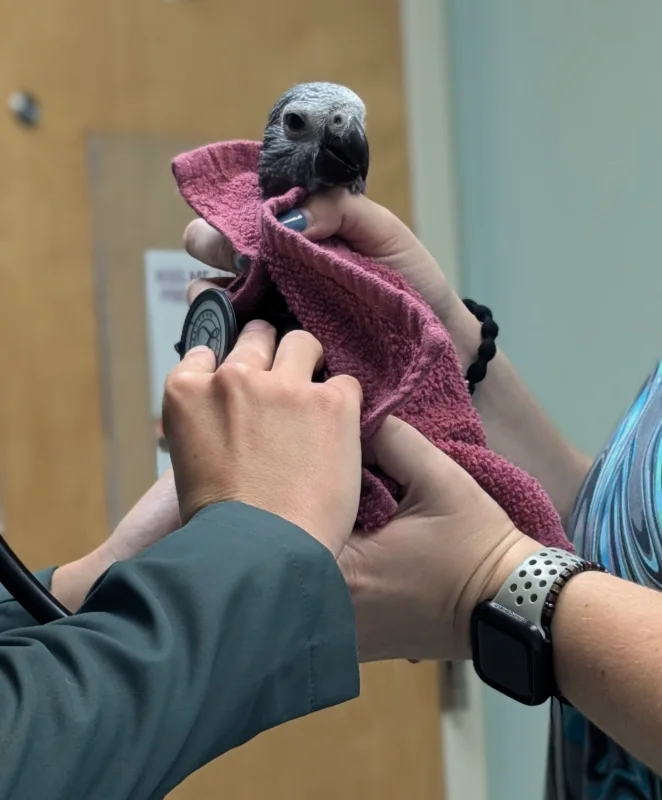
Egg Binding: We knew our beautiful Mango was due to lay her first egg because we took her to the vet for a wellness check. Prior to the visit, in anticipation of her becoming mature enough to lay, she was being monitored carefully, and her diet was exactly what it should have been to successfully lay her first egg. We did everything right. Despite our preparation, she became egg bound. We caught it quickly and tried every method known to mankind to save her. Ultimately, she required surgery. She made it through the surgery but crashed as we arrived to take her home. Sometimes, no matter how much you know or how hard you try, Mother Nature has different plans.
How does a hen present when egg bound? She will first become “fluffed up”. You will notice her straining in an attempt to lay the egg. Her back side will become red and inflamed from pressure. Many times, the hen will stay at the bottom of her cage and show little if any interest in eating or drinking. This is a life threatening condition.
Time is of the essence with an egg bound bird. This is one reason why one should not breed birds recklessly. Please be cognizant of the fact that a male does not need to be present for a female to begin laying eggs. We will reiterate once more why DNA sexing is extremely important. Prior to acquiring a female bird, please research the nutritional requirements she will require, the symptoms of egg binding and your closest avian emergency veterinarians. During the emergency is NOT the time to figure the above out.
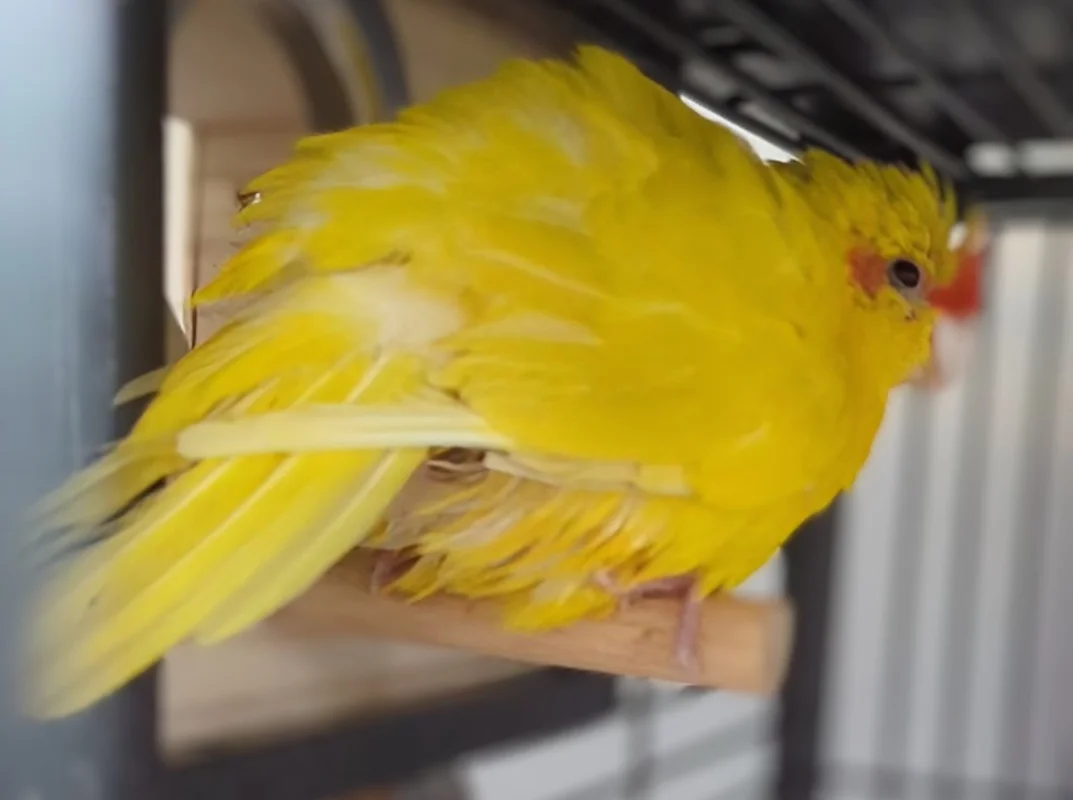
Discharge in Nares (Nostrils)/ Sneezing: Chances are, if you see discharge coming out of your bird’s nostrils, they have been ill longer than you realize. Birds have an uncanny ability to hide ailments. Sometimes, it’s too late when they become symptomatic. Any sneezing, wheezing or discharge, clear or not, is cause for alarm. Go to your vet IMMEDIATELY. We take close up pictures weekly if not daily to check all of our birds’ nares. This is a good habit to keep enabling you to catch changes quickly.
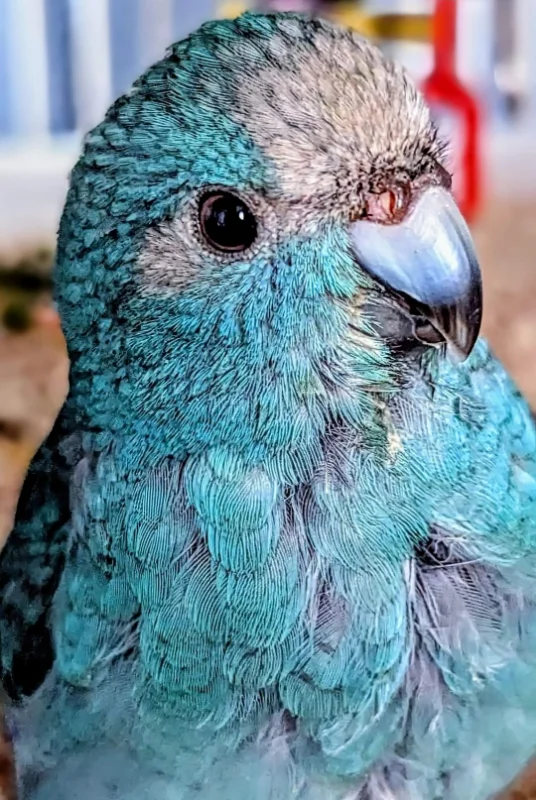
Change in Activity: If your bird is calmer than usual, this can be a signal that something is not right. It is better to be safe than sorry. Make that vet appointment.
Tail Bobbing: When you witness your bird fluffing up, breathing heavily and quietly “tail bobbing” on his/her perch, this is a sign that your bird is in distress. Do not discount this behavior as just trying to balance. Tail bobbing is life threatening and should warrant an immediate vet visit.
Bleeding: The first thing that you should have in your first-aid kit is Kwik-Stop. If you do not have any on hand, cornstarch and baking soda can be used. We have even heard of individuals using soap to coat a nail. Birds can bleed out from a damaged or broken toenail. This can happen right before your eyes if you are not prepared..
Our Indian Ringneck, Calypso Blue, broke half of his nail off after snagging it on an unknown object. We tried Kwik- Stop, ice and applying pressure but nothing seemed to work. Finally, the bird was held upside down with pressure on the wound for over an hour until the bleeding stopped. Luckily Calypso was extremely socialized and trusting so he allowed us to administer first aid without even wrapping him in a towel. We truly believe that this trust avoided him going into shock. He was promptly taken to the vet and had to have the nail removed and cauterized.
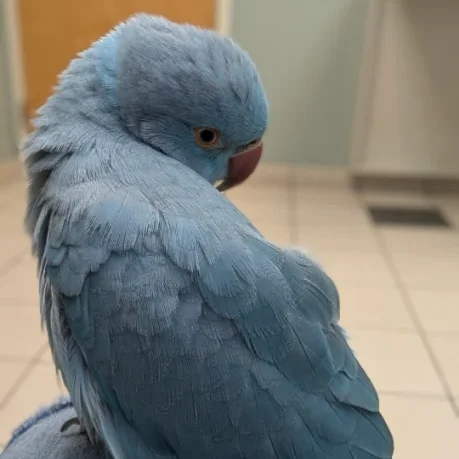
Is My Bird Depressed?
Do birds suffer from depression? ABSOLUTELY. A myriad of situations can lead to depression in a bird. Perhaps their best buddy passed away or their human rehomed them. Whatever the cause, it is important to identify the signs that your bird is depressed. When someone calls us about a depressed bird, we usually ask the following questions:
- Has anything in the bird’s environment changed?
- Have you lost anyone (human or animal) recently?
- Have you shifted or shared your affections with anyone new lately?
- Has the bird’s diet changed?
- How often do you change toys?
Any of the above can be contributing factors when determining whether or not your bird is depressed. We have experienced depression in our flock three times. Twice after a bird’s best friend died and once when we took back one of our babies after he had been exposed to mold in his new home. One of the birds whose mate died, Bob, was so distraught that he stopped eating altogether. Ultimately, it was another male (who he hated prior to his loss) that saved him by force feeding him until he bounced back from his hunger strike..

The most tragic loss we experienced resulting in an extremely depressed bird was our beloved Quaker Parrot, Tipsy. Tipsy took her job of protecting our handicapped bird, Pogo, very seriously. They were inseparable. Tragically, Tipsy aspirated on a small seed resulting in pneumonia. Although it was caught early and an entire team of avian vets tried to save her for four days, we ended up losing her. Pogo was beside herself in grief. Ironically, that same week, we were asked to hand feed a tiny Quaker baby. We named the little one Nugget and prayed for a girl. Her DNA came back just as we had hoped and we held our breath that Pogo would accept her. She did. A month after we lost Tipsy, Pogo spoke her first word, “Tipsy”. Tipsy might be watching over Pogo as an angel now but Pogo has not forgotten about her.

Keanu was one of our ringneck babies that was placed into a loving home. He was inadvertently exposed to mold and came back to us after he became symptomatic for a respiratory infection. He was quarantined for over a month per our vet’s instruction and began to show signs of depression. Once he was medically cleared, we put his brother, Kai, in the room with him. His demeanor changed immediately for the better. We are happy to report that the brothers were adopted together and will live out the rest of their years in their wonderful forever home.

Hazards in Your Home
“Bird- Proofing” Your Home
Face it! Birds excel in being naughty! The question is not if your bird will get into trouble. It’s WHEN your bird will get into trouble! They are sneaky little devils who show ZERO remorse when chewing your door frames or stealing your food.
Many times, we hear of someone’s bird suddenly becoming ill and dying for no apparent reason. One would be surprised by the common everyday household items that are toxic to our feathered friends. No matter how diligent you are when “bird proofing” your home, accidents can happen. We always take an opportunity to educate when someone can learn from our experiences.
We have had two instances where birds have tried to fly out of a room at the last second before we shut the door. ALWAYS close a door behind you slowly while keeping your eye on the bird. NEVER slam the door shut or close quickly. Look up one extra time just to be sure that your stealth bomber hasn’t made a clandestine landing!
You will be surprised at how fast a bird will land on the door trim and look down to see where you’re going. This can have a tragic outcome if you are not constantly aware of where your bird is when leaving a room (or your house).
Our ringneck, Chakra, can “zipper” the edge of a blind in 30 seconds. He takes great pride in this talent and once ruined an entire set of blinds while visiting a friend’s vacation home. You’re probably thinking, “Why wasn’t he monitored?” We were sitting right beside him! He was quiet as a mouse! Needless to say, we do not have blinds anywhere that are accessible to a bird in our home. Prior to the blind removal, we cut the strings off to be extra cautious. I walked in one morning to see him hanging upside down with his foot caught in an inch and a half of string that he had pulled out from the top of the blind (he was fine). Accidents happen. Be prepared!
We have found the following article to be one of the most comprehensive resources on how to best provide a safe environment for your bird.
https://nilesanimalhospital.com/files/2012/05/Household-Hazards-2013.pdf
First Aid
First Aid Basics
Emergencies are inevitable. Preparing in advance and having resources easily accessible are extremely important when faced with a dire situation. The NUMBER ONE tip we can provide is to have two lists of avian veterinarians programmed into your phone. You will need a primary avian/exotic vet who is available during standard business hours and at least two additional backups in case one vet is not available. The second list should be comprised of the closest emergency clinics who have an avian vet on premise. Do not assume that a “regular” veterinarian is knowledgeable about birds. Most are not. Your first question after asking if there is an avian vet on staff is, “Do you have an oxygen chamber?” Many bird emergencies are not discovered until a bird is symptomatic. Time is of the essence. The following is a great first aid guide that can equip you with just enough knowledge to act swiftly when faced with an emergent situation.
Frequently Asked Questions
What is the Best Sized Cage for My Bird?
Your bird’s happiness is directly correlated to its environment. Choosing the right cage can be tricky with so many shapes and sizes on the market. One thing to consider when bringing a younger bird home is that it will most likely be smaller than what the suggested safe guidelines are for the breed. Bar spacing is extremely important. A baby can get stuck in between bars or escape when the spacing is too wide. We use travel cages when our babies are too small to be placed safely into their permanent cages. Keep this in mind when researching cages.
Two additional tips that we have found to be very helpful when keeping our babies safe are:
1. Remove any seed guards from around the bottom of a cage. They have sharp edges that can cut your bird if it doesn’t land properly (we speak from experience). Seed guards also take up a tremendous amount of space. We are not fans. We use puppy pads under our cages.
2. Take the grate out of the bottom of your cage. Grates make it difficult for a young bird to walk when they are first trying to navigate their new environment. You can simply line the bottom with white paper towels or a puppy pad. We have never had an issue with either.
Below is a link with resources that might alleviate a lot of frustration when searching for a cage.
What Size Cage Should My Parrot Have? Essential Space Guidelines for Healthy Birds – ThisBirdTalks
What Small Birds are the Best Talkers?
This is one of the most frequently asked questions. “Will this baby talk in the future?” Although one never knows if a bird will talk even if it has the capability, the following birds have been known to be great talkers:
Parrotlets, Kakariki, Budgies,Cockatiels, Quaker (Monk) Parrots,Indian Ringnecks, African Grey Parrot, Eclectus Parrot, Yellow Naped Amazon, Cockatoo, Macaw and the Myna.
Who ranks on the top of the list? The African Grey is considered to be one of the most intelligent talkers with the ability to learn up to 1,000 words or more!
Here is a fun video of a little Kakariki named Tango chatting up a storm as he prepares for bedtime!
https://youtube.com/shorts/VkD8HLz1dds?
How Can You Tell if an Egg is Fertilized?
Are you candling an egg trying to figure out if it’s fertilized? A fertilized egg can survive a few days without being incubated if the conditions are right. Once you begin the candling process, don’t give up unless you have waited at least a couple of days to see any changes. The following video shows an egg from day one in the incubator until it hatches. There’s nothing more gratifying than witnessing that first heartbeat inside of the egg.
https://youtu.be/XvJ1hQpAGc0?feature=shared
“What does foraging mean and why is it important?”
(1) What Does Foraging Mean and Why Is It Important? – YouTube
“How do I know if my bird is egg bound?”
“Why is my bird acting crazy? What does mating behavior look like?”
“Why is my bird making this sound?”
Understanding and Interpreting Your Bird’s Vocalization #birds #parrot #birdsounds #birdslover
“Why does my bird pin its eyes?”
Why Do Birds “Eye- Pin”? #birds #parrot #aggression #ringneckparrot #birdslover #animals #parakeet
“Why doesn’t my bird like to be touched?”
Why Doesn’t My Bird Like to Be Touched? #birds #parrot #ringneckparrot #caiqueparrot #aggression
“Why do baby birds flap their wings?”
Why Do Baby Birds Flap Their Wings? #birds #parrot #birdslover #pets #cute #quakerparrot #bird
“Why does my baby bird make sounds and grind its beak when sleeping? Is this normal behavior?”
Why Does My Baby Bird Make Sounds While Sleeping? #birds #parrot #birdslover #sleep #babybird #bird
“Why is my baby bird bobbing its head?”
Why Does My Bird Bob Its Head? #birds #parrot #birdslover #headbob #cute #indianringneck #babybird
How do you teach your baby bird how to perch?
Baby Birds Learning How to Perch #birds #parrot #birdslover #pets #indianringneck #perch #cute
Did you know?
Wise as an owl: According to Greek culture, Athena the Greek goddess of wisdom and knowledge was always illustrated with an owl on her shoulder which created the myth of the owls being wise and intelligent. An individual referred to as “wise as an owl” is considered to be of sound judgment, discerning and exceptionally wise.
Don’t be a “booby”! Be the owl! Stay informed!